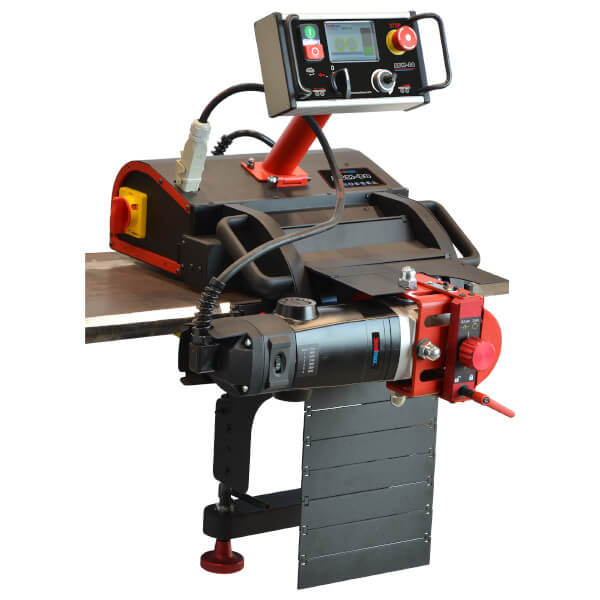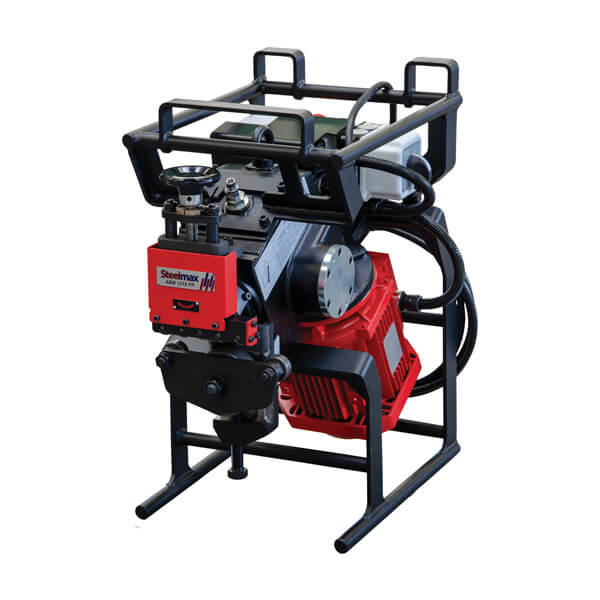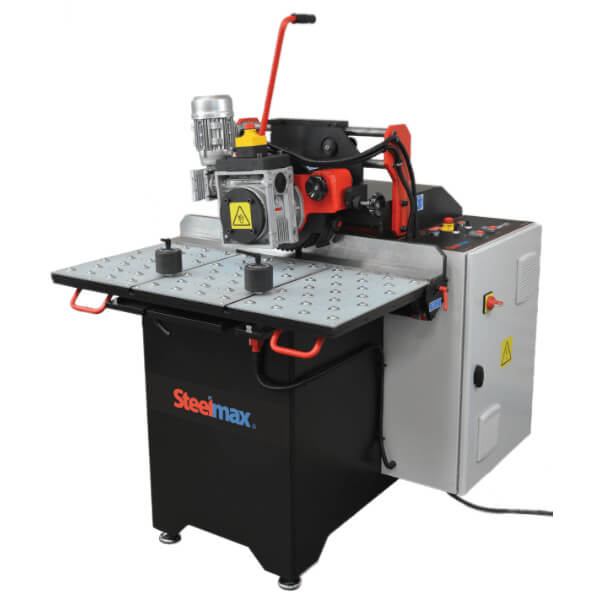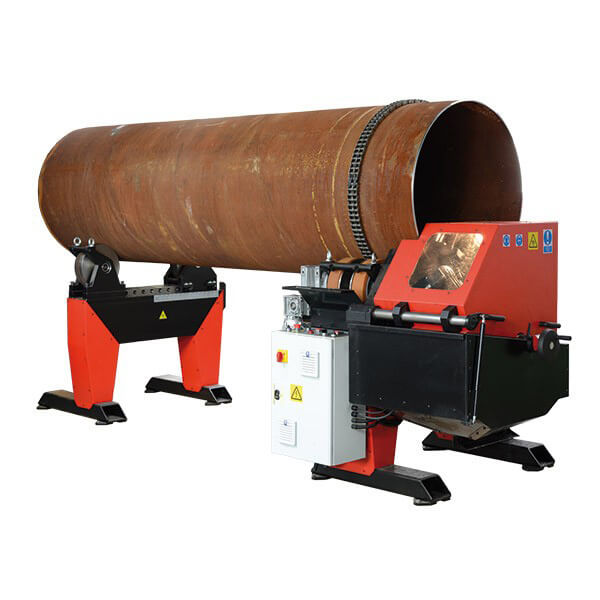Mechanized beveling is an essential part of any metalworking production plant. Before welding any workpiece in an angle, some beveling must take place.
Nevertheless, there are different ways to do this, and not all the equipment works equally fine. What can help you to achieve a perfect mechanized beveling fo each workpiece, each time? That is the scope of this article. But let’s get started by answering the basics first.
What is mechanized beveling?
Mechanized beveling refers to the process of creating angled or V-shaped edge preparations on metal components using specialized power tools and equipment. This is achieved through various cutting or shaping techniques, as opposed to manual methods like grinding.
Some key features of mechanized beveling
Common beveling operations include J-prep, V-prep, X-prep cuts, countersinks, backfacing, and clipping to prepare metals for welding. The angles and dimensions of the bevels depend on the welding requirements.
Beveling can be done on plates, pipes, vessels, beams and other metal pieces to provide appropriate grooves, allow proper weld penetration, and enhance the strength of welded joints.
It is faster and provides more reproducible results and quality bevels versus manual grinding or flame cutting bevels (like plasma or oxyfuel). The cutters can be adjusted to control bevel angles accurately.
Mechanized equipment allow both stationary beveling where components are moved into place as well as on-site mobile beveling brought to large assemblies. Mechanized beveling aims to improve welding quality and productivity by using power-assisted tools to consistently create precision bevel profiles on metal edges in preparation for welding. It reduces the labor while enhancing accuracy and repeatability of required weld preparations.
This equipment play a crucial role in modern fabrication by enhancing quality, productivity, and safety in various industries like shipbuilding, construction, and metalworking.
When mechanized beveling is needed
Mechanized beveling is needed in various situations where a precise and consistent angled edge is required on a workpiece. Here are some specific scenarios where it comes into play:
1. Welding Preparation
Creating a V-groove or J-groove: This allows for deeper weld penetration and stronger welds in various applications like pipe welding, structural steel fabrication, and shipbuilding.
Facilitating root gap control: Beveling helps establish a consistent gap between the joining pieces, crucial for proper weld penetration and avoiding defects.
2. Welding Specifics
High Volume Production Welds: It significantly reduces the work and time needed to bevel components when there are many continuous weld joints to prepare.
Safety-Critical Welds: Some welds like pressure vessel joints require validated, reliable beveling methods to meet quality standards every time. Mechanized does this.
High Cost of Grinding Discs & Worker Injuries: Manual grinding utilizes many abrasives, risks repetitive stress issues and has higher incident likelihood. Mechanized beveling mitigate these.
3. Edge Finishing and Aesthetics
Creating decorative or functional chamfers: Beveling can be used to create smooth transitions between edges for aesthetic purposes or to improve functionality in applications like handrails or machinery components.
Preparing edges for painting or coating: A beveled edge can provide better surface coverage and adhesion for paint or other coatings.
4. Material Removal and Shaping
Removing excess material: Beveling can be used to efficiently remove unwanted material from the edge of a workpiece, particularly in preparation for further processing or joining.
Creating specific edge profiles: Certain mechanized beveling machines offer the ability to create complex edge profiles beyond simple angles, catering to specialized applications.
5. Specific Material Considerations
Heat-sensitive materials: Mechanized beveling, particularly using non-thermal methods like milling, is preferred for materials susceptible to heat distortion caused by thermal cutting processes like oxy-fuel or plasma.
Thick materials: Beveling thicker materials can be challenging and time-consuming with manual methods. Mechanized solutions offer greater efficiency and control in such situations.
In essence, whenever a project requires precise edge preparation, improved weld quality, enhanced aesthetics, or efficient material removal, mechanized beveling becomes a valuable tool for achieving these goals.
Advantages of mechanized beveling
Mechanized beveling offers several advantages over traditional manual methods, making it a preferred choice in various fabrication applications. Here are some key benefits:
Increased Efficiency and Productivity
Faster completion times: Mechanized solutions typically operate at higher speeds and require less setup time compared to manual grinding or hand tools. This result is higher fabrication productivity.
Reduced labor costs: Automating the beveling process reduces reliance on manual labor, leading to potential cost savings.
Batch processing capability: Certain machines allow for processing multiple pieces simultaneously, further enhancing efficiency for large-scale projects.
Cost Effectiveness: Despite higher initial equipment costs, mechanized beveling saves significantly on consumable discs/wheels, worker labor hours, weld repairs and qualifications through consistency and speed.
Improved Consistency and Precision
Accurate bevel angles and depths: Mechanized machines ensure consistent and precise bevel geometry throughout the workpiece, crucial for proper weld penetration and joint fit-up.
Repeatable results: Once settings are established, the machine consistently replicates the desired bevel profile, eliminating human error and variations in manual methods. This reliability is critical for industries like shipbuilding.
Reduced rework and scrap: Consistent beveling minimizes the risk of errors and the need for rework or scrapped materials due to uneven or inaccurate bevels.
Enhanced Safety
Reduced operator fatigue: Automating the process minimizes physical exertion and fatigue for workers, leading to improved safety and reduced risk of injuries.
Lower dust and fume exposure: Compared to manual grinding, mechanized beveling often generates less dust and fumes, creating a safer work environment.
Reduced noise levels: Certain mechanized solutions operate with lower noise levels compared to power tools commonly used in manual beveling.
Versatility and Adaptability
Suitable for various materials: Different types of mechanized beveling machines can handle a wide range of materials, from mild steel to stainless steel and even thicker materials.
Multiple bevel options: Machines often offer the ability to create different bevel angles, depths, and even complex profiles depending on specific application requirements. Tools can be equipped with different cutters to create various bevel designs like J, V, X, Y, K styles per application by just changing the setup.
Portable solutions available: Some mechanized beveling solutions are portable and can be easily used on-site for various fabrication needs.
Additional advantages
Improved weld quality: Consistent bevels contribute to better weld penetration and fusion, leading to stronger and more reliable welds.
Enhanced aesthetics: Mechanized beveling can create clean and uniform edges, improving the overall visual appeal of the finished product.
Reduced environmental impact: Compared to thermal cutting methods, certain mechanized beveling processes generate less heat and fumes, contributing to a more environmentally friendly approach.
Now, not all mechanized beveling equipment is equal or solve the same problem. Let’s see now the types of mechanized beveling available.
Types of mechanized beveling
The most common types of mechanized beveling processes can be broadly categorized into the following ones, based on the method used to create the bevel:
Thermal beveling
Oxyfuel beveling: This traditional method utilizes an oxy-fuel torch to create the bevel by burning away the material. It is suitable for simple bevels on thicker materials like steel plates.
Plasma beveling: This method employs a plasma torch that generates a high-temperature, ionized gas stream to melt and remove material. It offers faster cutting speeds and cleaner cuts compared to oxyfuel cutting, making it suitable for various materials and bevel shapes.
Mechanical Beveling
Milling Beveling: Uses rotary end mills and side mills with custom tooth geometries mounted on machines that can be moved along plates or pipe intersect joints to create precise beveled grooves. They offer high precision and versatility for creating different bevel shapes and angles.
Disc Cutting Bevelers or Grinding machines: Employs adjustable, powered grinding discs like cold saws. Different angle plates produce the required bevel profiles in materials. Portable magnetic based versions exist. They are suitable for simpler bevels on various materials.
Router Beveling: Involves programmable pneumatic routers mounted on frames or wagons that feed rotating cutters along the weld seam line. Floating heads maintain constant pressure against the surface.
Orbital beveling: Uses rotary multi-axis heads with specialized cutters that plunge linearly into material at the weld joint while the head orbits in a circular pattern to create compound bevels.
Drill Beveling: Programmable multi-spindle drilling columns or drilling robots create the required holes and edge profiles needed for welding applications like nozzle inserts into pipes or vessels.
The choice depends on needs like portability, materials, weld types (V,J grooves), accuracy, one-offs vs production use and budget. Semi-automated progression helps improve mechanized bevel quality further.
Applications of mechanized beveling
Mechanized beveling finds application in a diverse range of industries and processes, primarily due to its ability to create precise and consistent angled edges. Here are some of the main areas where it plays a crucial role:
Welding Preparation
Pipe welding: Beveling is essential for pipe ends before welding, ensuring proper fit-up, weld penetration, and joint strength. It is extensively used to put bevels at intersecting joints for lining up pipes and welding vessel nozzles, hatches, pumps etc. Allows multi-axis compound bevels.
Steel plate fabrication: Beveling is used to prepare plates for welding in various structures like buildings, bridges, and ships. Mechanized solutions ensure accurate bevels across large plates, leading to improved weld quality and overall structural integrity.
Pressure Vessels and Storage Tanks: Used on heads, shells and nozzle connections to meet strict edge preparation and quality standards needed in this industry. Lowers contamination and improves seal welds around wall rolled joints and floor to shell connections.
Structural steel construction: Beveling facilitates the joining of different structural steel members. Steel structures like bridges, cranes, towers utilize it to create beams and column bevel cuts to specification for easier bolting and welding on site. Mechanized methods offer efficiency and precision, ensuring proper load transfer and structural stability.
Edge Finishing and Aesthetics
Handrails and architectural elements: Beveling can create smooth and visually appealing edges on handrails, balconies, and other architectural components. Mechanized solutions ensure consistent edge profiles, enhancing the aesthetics of the finished product.
Machinery components: Beveling can be used to create chamfers or specific edge profiles on machinery parts for improved functionality or aesthetic appeal. Mechanized solutions offer precise and repeatable bevels, crucial for proper component fit and performance.
Material Removal and Shaping
Removing excess material: Beveling can be used to efficiently remove unwanted material from the edge of a workpiece, particularly in preparation for further processing or joining. Mechanized solutions offer faster and more controlled material removal compared to manual methods.
Creating specific edge profiles: Certain mechanized beveling machines offer the ability to create complex edge profiles beyond simple angles, catering to specialized applications like tool and die making.
Additional Applications
Shipbuilding and offshore applications: Beveling is crucial for preparing steel plates and other components for welding in ships and offshore structures. Mechanized solutions ensure the strength and integrity of decks, bulkheads, shells and other structural joints.
Aerospace and transportation industries: Beveling plays a role in preparing components for welding and other joining processes in these high-precision industries. Truck trailer and railcar fabrication apply it make accurate bevels on the frames, coupling plates, and body panels during assembly. Mechanized solutions ensure quality and consistency in these demanding applications.
Metal Furniture: Facilitates mass production of furniture from frames to racks using reliable, automated beveling for joints.
Factors to consider when choosing a mechanized beveling machine
Choosing the right mechanized beveling machine depends on several factors specific to your project and needs. Here are some key considerations:
Material
Type of material: Different materials have varying hardness, thickness, and heat tolerance. Choose a machine compatible with your material. For example, plasma cutting might be suitable for mild steel, but milling may be preferred for heat-sensitive materials like aluminum.
Thickness: Consider the thickness of your material. Some machines excel at handling thicker materials, while others are better suited for thinner sheets.
Bevel Requirements
Desired angle and depth: Ensure the machine can achieve the required bevel angle and depth for your application. Some machines offer fixed angles, while others allow for variable adjustments.
Profile complexity: Do you need simple straight bevels, or do you require complex profiles like J-grooves or U-grooves? Choose a machine capable of handling the desired profile.
Operational Needs
Portability: Do you need a portable machine for on-site work, or will it be used in a stationary workshop? Consider the size and weight of the machine.
Ease of use: Evaluate the complexity of setup and operation. If you have limited experience, prioritize user-friendly machines with clear instructions and minimal maintenance requirements.
Production volume: For high-volume production, consider machines with faster processing speeds and automated features.
Budget
Machine cost: Beveling machines range in price depending on capabilities and features. Set a realistic budget and compare options within your range.
Operating costs: Consider consumables like cutting tools or grinding wheels, as well as energy consumption and maintenance costs. How frequenly will that machine need maintenance?
Additional factors
Safety features: Choose a machine with safety features like guards, emergency stops, and dust extraction systems.
Brand reputation and warranty: Consider the brand’s reputation for quality and customer service, and compare warranty offerings.
Availability of service and support: Ensure the machine has readily available parts and service support in case of issues.
Consulting with manufacturers representatives, like us, can provide valuable insights and recommendations based on your specific application. Feel free to contact us anytime.
Equipment for mechanized beveling
There is a large number of equipment available for mechanized beveling, covering virtually every possible need in the industrial world. The following are just a few examples of equipment we have sold to our customers that have effectively met their needs.
ABM 30 Auto Feed Double-Sided Beveling Machine
The Steelmax ABM30 beveling machine by Steelmax produces accurate high-quality machined bevels on plate thickness from 5/16” to 2-3/8” (8- 60mm) using a rotary milling head with replaceable carbide inserts.
The ABM 30 features an adjustable bevel angle from 0 to 70 degrees for both topside and bottom side beveling and can produce a maximum bevel width in multiple passes up to 1-3/16” (30mm).

ABM1218 FR Double-Sided Plate/Pipe Beveling Machine
The Steelmax ABM1218 is a portable beveling machine capable of producing weld-ready bevels on flat plates of any shearable material up to 100,000 psi tensile strength. The ABM1218 FR uses a shearing process that is silent and fast.
A powerful 3 horsepower electric motor drives the machine at speeds up to 8.5 feet per minute, making it the most powerful machine in its class. The machine can produce a 1/2” (12 mm) wide bevel in a single pass and can produce a maximum 3/4” (18 mm) wide bevel on plates or round tubes from 1/4” (6 mm) to 1-9/16” (40 mm) thick in multiple passes.
A 30° bevel angle attachment is included and interchangeable bevel angle attachments are available for 22.5°, 25°, 30°, 35°, 37.5° and 45° bevels. The machine is easily inverted to bevel the underside of the plate – eliminating the need to flip the material – improving operational safety and increasing productivity.

SBM 500 Stationary Beveling Machine
The Steelmax SBM500 is a robust and efficient solution for beveling and deburring steel plate, angle, square/rectangular tubing and pipe. The SBM500 features a high-speed rotary milling head with carbide inserts that produces a clean, milled surface without thermal distortion or a heat affected zone.
Variable feed rates and precise milling head speed control produce repeatable and accurately milled weld preparations in both ferrous and non-ferrous materials; improving part fit-up resulting in better welds. Accurate weld preparation reduces over welding, defect repair and production time, significantly lowering production costs. With the capacity to produce bevels up to 1-3/16” wide on plate up to 4” thick, the SBM500 is a unique solution for fabricators that need a high throughput beveling solution.

PBM 1000 High Speed Pipe Beveling System
The Steelmax SM-PBM 1000 is designed for beveling and facing pipes, tanks or tubes with diameters ranging from 8″ – 40″ (200 mm – 1000 mm). It is capable of machining bevel widths up to 1-3/4″ (45 mm) within a range of angles from 0° – 60°.
An exclusive “J” groove beveling attachment is also available. With its high-speed rotary milling head, PBM 1000 produces accurate bevels in a fraction of the time required by traditional single point machining. This saves time and money and improves accuracy.

Let us help you with your mechanized beveling needs
Mechanized beveling it is not an option, but a must, in many industries, specially when it comes to construction and shipbuilding. These industries handle projects that must remain for years to come, so their processes need to be reliable.
We have been working with welding and cutting for over 45 years. Regarding mechanized beveling we have a lot of experience. Feel free to contact us at your earliest convenience.




